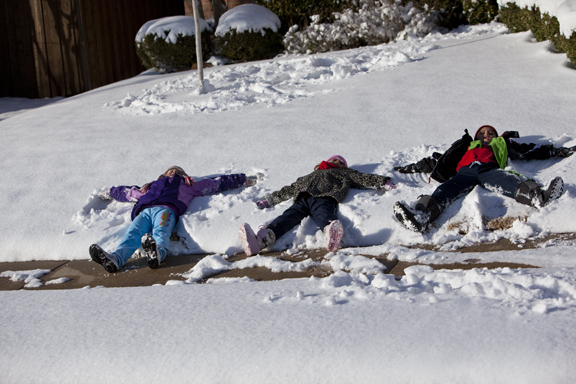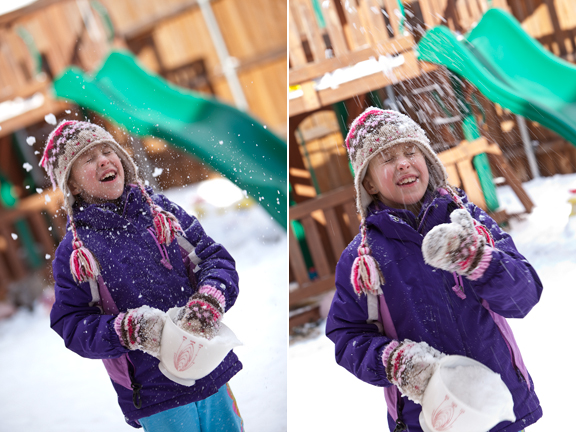
Last week my oldest had FOUR snow days off from school. Yep, you read that right. Here in the state of TEXAS we had FOUR DAYS OFF due to ICE and SNOW. Rumor has it tonight's weather may bring a repeat.
(Insert silent scream...)
If you are like me, the first day was FUN. Day two...CABIN FEVER started to set in. By day three, let's just say I had to have a nice little chat with God to get my attitude back on track - if you know what I mean.
Thankfully, I joined a Photography Forum on Facebook earlier this year, and February's challenge is on shutter speed. Perfect timing! Snow ball fights, sledding, and street ice-hockey are perfect for shutter speed exercises. Outside I went with my camera in hand. It wasn't long before I discovered that I didn't have to be on the roads or out shopping to have fun - all I needed was MY CAMERA - and my adorable FAMILY, of course!
So, with today's news of more of the same (i.e. snow, wintery-mix) coming our way, I thought you might like a little photography "project" of your own to help pass the time. Why not learn about shutter speed?
What is shutter speed?
Shutter speed refers to the length of time a camera's shutter remains open when taking a photograph - a common term used to discuss exposure time. It determines the amount of light that reaches the film or sensor and is measured in seconds or fractions of seconds. The bigger the denominator, the faster the speed (i.e. 1/2000 is much faster than 1/30).
I've posted some images below - along with their "shot recipe" (my camera settings) - to give you ideas on how you can better capture and document these snow-bound days.
FYI: This is not an in-depth lesson. If you'd like to learn more about shutter speed, visit my original Lesson on Shutter Speed on our old blog for more exercises.
Though this lesson is mainly intended for those of you who shoot manually, it will also work in the tV (or Timing/Shutter Speed Priority) Program modes on any SLR/dSLR. Some point and shoot cameras may have a "Sports" program setting that will freeze motion as well.
And now for today's lesson:
Shutter speed can affect your images in various ways. Today I am only going to focus on how it affects motion. The following pictures will illustrate how you can manipulate your camera's shutter speed to either "stop" action (with a fast shutter speed) or "slow motion" (with a slow shutter speed).
To Stop Action: Select a shutter speed of at least 150/sec or faster.
To Slow Down the Motion: Select a shutter speed of at least 1/30 sec or slower.
In this first image, I used a fast shutter speed on the left (1/400 sec, ISO 50, f/2.8) and a slower shutter speed (1/30 sec, ISO 50, f/9.0) on the right.

With a fast shutter speed the camera's sensor is only exposed to the light for a split second, so it only "records" a fraction of the action. This produces a very tack-sharp image (as long as you are holding your camera steady). In this particular image (above left), it captures - and seems to separate - the individual snow chunks as they are thrown into the air.
A slower shutter speed leaves your camera's shutter open longer. This allows your camera's sensor to record more of the action. In the image on the right, this slower shutter speed allows the camera's sensor to record the falling snow as a trail of snow dust in the air.
Keep in mind, with a shutter speed that slow, it is important to hold the camera very steady (or better yet, use a tripod).

The image on the left above was shot at 1/6000 sec (to separate the snow even more), ISO 125, at f/2.8. On the right, I slowed the shutter speed down to 1/25 sec, ISO 100, at f/20. I didn't have my tripod outside, so I had to hand-hold the camera. I couldn't slow the shutter down any more than that without creating camera shake from my hands.
You'll notice that as I slowed down my shutter speed, I had to adjust the aperture accordingly to maintain a correct exposure. The article on OUR OLD BLOG (link posted above) explains this in more detail.
The following two images are just plain fun! Who would have thought my husband would be ice-skating in our street! And, even though we didn't have a sled, we made do. A cafeteria style tray did the trick just fine. What awesome memories these pictures will hold for our family in years to come!

The image on the left was taken at 1/15th sec, ISO 250, at f/2.8. I told my husband to stand as still as he could while the children skated past him. I sat on the curb and supported my camera with my hands while resting it on my knees. All of the images on today's blog were taken with my 70-200 mm lens as close to 200 mm as I could get. Having Steve stand still helps to exaggerate the motion of our neighbor boy skating past him. It was exactly the affect I was after!
Now, if you look closely, you'll notice Steve's face is slightly out of focus. This is because I was too lazy to go inside and grab my tripod. With a tripod, you eliminate camera shake caused by hand-holding your camera. Ideally you should not hand-hold your camera at a shutter speed lower than the longest focal length of the lens you are using. I was using a 70-200 mm lens. This means my shutter speed should not go lower than 1/200 sec. Taking that into consideration (and the fact that I was shivering cold), I'm rather pleased with my hand-held attempts here!
The sled picture on the right was taken at 1/5000 sec, ISO 125, at f/2.8. So, even though Stephen was barreling down the hill, I was able to get a crystal-clear, tack-sharp image that perfectly captured his priceless expression of joy - with a hint of fear!
Don't you want to get pictures like this of your children? Bring on the scrap books! You'll be the star of your next scrap-booking overnighter for sure.
But, even if you don't have children (or like them), you can try these same techniques with your pets - or even out in nature. These next two images were taken right outside my front door, so I didn't have to go very far. And if we do get snow again, I'll do my best to head out (with my tripod) to the local creek to get some rushing water-fall images for you.

The image on the left was taken at 1/800 sec, ISO 50, at f/2.8. Coincidentally, the image on the right was taken using the exact same settings (even though these were taken on different days). Both images show how a fast shutter speed stops motion. You can see every single drop of water - even though the water stream was flowing quite quickly to the ground.
Very Cool!
As you can see, my camera was the perfect companion during these past few wintery days. I was having so much fun, even the cold didn't bother me - THAT MUCH!
So there you have it. Now you're ready for another snow day, too! Grab your camera, bundle up those kids (or pets), and get in on some "action" of your own.
I hope you'll have fun too!

No comments:
Post a Comment
Thanks for stopping by!